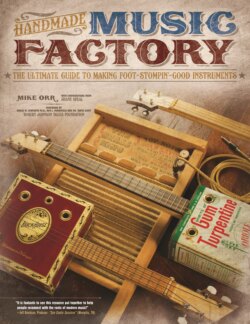Читать книгу Handmade Music Factory - Mike Orr - Страница 11
На сайте Литреса книга снята с продажи.
ОглавлениеIt is no accident that at the same time African
Americans were creating the lyrical and musical roots
for the blues, they were also creating their own ad hoc
musical instruments. The earliest extant examples of cigar
box guitars, for example, stem from this period (although
reported history dates them to just before the Civil War).
By the 1880s, plans to build simple cigar box banjoes
were appearing in print. While there were, of course, white
children who also built their own homemade instruments,
the particular poverty of the southern Black made such
creations more of a necessity than a social curiosity. If you
were a young southern Black growing up on a plantation,
and you wanted to learn to play guitar, it was almost a
given that you’d have to make one yourself. And this is
precisely what Robert Johnson, and so many before and
after him, did.
Johnson’s childhood friends recall how he took three
strings of baling wire and nailed them to the side of the
sharecropping shack he shared with his mother, Julia,
and stepfather, Dusty Willis, in Commerce, Mississippi.
Johnson slid two bottles under the wires to increase the
tension, and then picked out tunes on his homemade
diddley bow. And while those same friends said they
couldn’t make any sense out of what he was playing, no
doubt to the young Robert it was pure music. It wasn’t
long after that that Robert got his first guitar, but the roots
of his music had been laid on the homemade diddley bow.
The great slide-guitar evangelist Blind Willie Johnson
began on a one-string cigar box guitar. Big Bill Broonzy,
Muddy Waters, B.B. King, and so many others did likewise.
It’s not stretching the point too far to wonder whether the
blues would have developed as they did had it not been for
these homemade instruments. Mike Orr does a wonderful
job of relating this tradition to a new generation of America,
updating some plans to include electric pickups, while still
remaining true to the underlying impulses that gave birth
to the instruments and the music played on them. This
book deftly takes us through the creation of these
instruments so we can find our own connection with these
musical roots.
If the blues tell stories about life experiences revolving
around race, love, and social class, then these instruments
provide the background upon which those stories
were sung.
Robert Johnson’s musical acumen came as a result
of creating his own instrument to simulate the sound
of a guitar. It was that zeal to find solace in music that
comforted his soul as he lived a very transient lifestyle in
rural Mississippi. It is that same zeal that can be shared
through this book.
From L to R
Standing:
Steven Johnson, grandson
of Robert Johnson & VP;
Michael Johnson, grandson
of Robert Johnson &
Treasurer. Seated: Ben
L. Minnifield, VP Global
Marketing & Media; Dr.
Tanya Scott, VP Global
Business Development;
Claud Johnson, son of
Robert Johnson & founder;
Vasti Jackson, Artist &
Musical Director. Painting
by artist Earl Klatzel.
9
